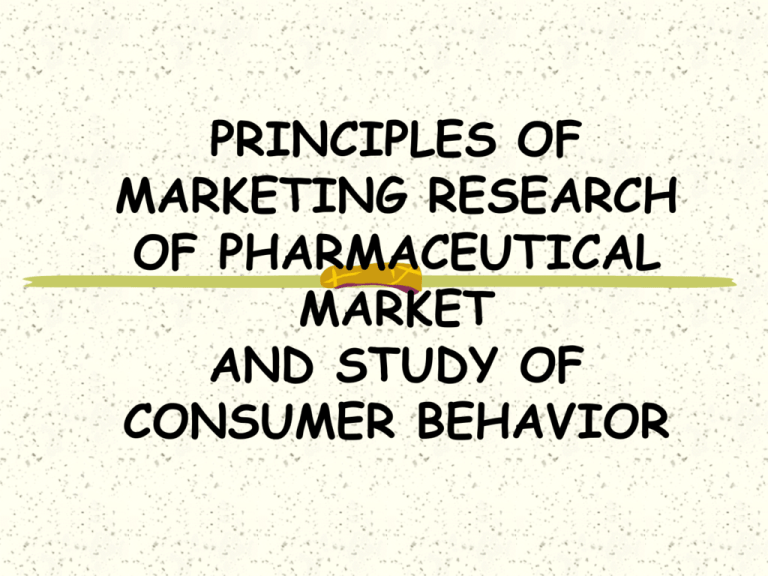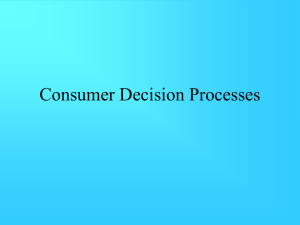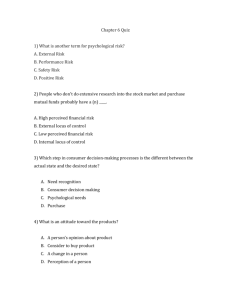Consumer Buying Behavior
advertisement

PRINCIPLES OF MARKETING RESEARCH OF PHARMACEUTICAL MARKET AND STUDY OF CONSUMER BEHAVIOR Marketing research is the systematic design, collection, analysis, and reporting of data and findings relevant to a specific marketing situation facing the company. Marketing research firms fall into three categories: Syndicated-service research firms: These firms gather consumer and trade information, which they sell for a fee. Custom marketing research firms: These firms are hired to carry out specific projects. They design the study and report the findings. Specialty-line marketing research firms: These firms provide specialized research services. The best example is the fieldservice firm, which sells field interviewing services to other firms. Effective marketing research involves the five steps: Gathering Information and Measuring Develop the research plan Collect the information Analyze the information Present the findings The second stage of marketing research calls for developing the most efficient plan for gathering the needed information. The marketing manager needs to know the cost of the research plan before approving it. Designing a research plan calls for decisions on the data sources, research approaches, research instruments, sampling plan, and contact methods. Data Sources The researcher can gather secondary data, primary data, or both. Secondary data are data that were collected for another purpose and already exist somewhere. Primary data are data gathered for a specific purpose or for a specific research project. Researchers usually start their investigation by examining secondary data to see whether their problem can be partly or wholly solved without collecting costly primary data. Secondary data provide a starting point for research and offer the advantages of low cost and ready availability. When the needed data do not exist or are dated, inaccurate, incomplete, or unreliable, the researcher will have to collect primary data. Most marketing research projects involve some primarydata collection. The normal procedure is to interview some people individually or in groups to get a sense of how people feel about the topic in question and then develop a formal research instrument, debug it, and carry it into the field. Primary data can be collected in five ways: observation, focus groups, surveys, behavioral data, and experiments. Observational research: Fresh data can be gathered by observing the relevant factors and settings. Focus-group research: A focus group is a gathering of six to ten people who are invited to spend a few hours with a skilled moderator to discuss a product, service, organization, or other marketing entity. The moderator needs to be objective, knowledgeable on the issue, and skilled in group dynamics. Participants are normally paid a small sum for attending. The meeting is typically held in pleasant surroundings and refreshments are served. Focus-group research is a useful exploratory step. Consumer-goods companies have been using focus groups for many years, and an increasing number of newspapers, law firms, hospitals and public-service organizations are discovering. Survey research: Surveys are best suited for descriptive research. Companies undertake surveys to learn about people’s knowledge, beliefs, preferences, and satisfaction, and to measure these magnitudes in the general population. Behavioral data: Customers leave traces of their purchasing behavior in store scanning data, catalog purchase records, and customer databases. Much can be learned by analyzing this data. Customers’ actual purchases reflect revealed preferences and often are more reliable than statements they offer to market researchers. People often report preferences for popular brands, and yet the data show them actually buying other brands. Experimental research: The most scientifically valid research is experimental research. The purpose of experimental research is to capture cause-and-effect relationships by eliminating competing explanations of the observed findings. Іnterviewing The following is a list of the different types of questions in questionnaire design: 1. Open Format Questions Open format questions are those questions that give your audience an opportunity to express their opinions. 2. Closed Format Questions Closed format questions are questions that include multiple choice answers. 3. Leading Questions Leading questions are questions that force your audience for a particular type of answer. In a leading question, all the answers would be equally likely. 4. Importance Questions In importance questions, the respondents are usually asked to rate the importance of a particular issue, on a rating scale of 1-5. These questions can help you grasp what are the things that hold importance to your respondents. 5. Likert Questions Likert questions can help you ascertain how strongly your respondent agrees with a particular statement. 6. Dichotomous Questions Dichotomous questions are simple questions that ask respondents to just answer yes or no. 7. Bipolar Questions Bipolar questions are questions that have two extreme answers. The respondent is asked to mark his/her responses between the two opposite ends of the scale. 8. Rating Scale Questions In rating scale questions, the respondent is asked to rate a particular issue on a scale that ranges from poor to good. Rating scale questions usually have an even number of choices, so that respondents are not given the choice of an middle option. Consumer Market Consists of all the individuals and households who buy or acquire goods and services for personal consumption. Before business can develop marketing strategies, they must understand what factors influence buyers behavior and how they make purchase decisions to satisfy their needs and wants. Buyers are moved by a complex set of deep and subtle emotions. Their behavior result from deeply held values and attitudes; their perception of the world and their place in it, from common sense, impulse or just plain whimsy. There are also several stages through which the consumer exhibit before deciding to purchase goods or services. These includes 5 steps which are: problem or need recognition, information search, alternative evaluation, purchase and postpurchase evaluation Consumer Buying Decision Process Problem Recognition Purchase Decision Information Search Evaluation of Alternatives Post-Purchase Evaluation Consumer behavior involves study of how people buy, what they buy, when they buy and why they buy. It blends the elements from psychology, sociology, sociopsychology, anthropology and economics. It also tries to assess the influence on the consumer from groups such as family, friends, reference groups and society in general. Consumer buying behavior is influenced by the major factors: Personal Psychological Social Cultural Situational Personal Factors Age Life-Cycle Stage Gender Health Status Financial Resources Housing Psychological Factors These are internal to an individual and generate forces within that influence her/his purchase behavior. The major forces include motives, perception, learning, attitude and personality Psychological Factors “Wants” Based on a want or desire to have something. Not a necessity. Psychological Factors Motivation: Motivation is the psychological feature that arouses an organism to action toward a desired goal and elicits, controls, and sustains certain goal directed behaviors. For instance: An individual has not eaten, he or she feels hungry, and as a response he or she eats and diminishes feelings of hunger. There are many approaches to motivation: physiological, behavioural, cognitive, and social. Psychological Factors Motivation Perception The process by which an individual selects, organizes, and interprets inputs to create a meaningful picture of the world. Selective Exposure Selective Distortion Selective Retention Psychological Factors Motivation Perception Learning Changes in an individual’s behavior arising form experience Psychological Factors Motivation Perception Learning Beliefs Descriptive thoughts that a person holds about something Psychological Factors Motivation Perception Learning Beliefs Attitudes Enduring favorable or unfavorable cognitive evaluations emotional feelings and action tendencies Social factors play an essential role in influencing the buying decisions of consumers. We need people around to talk to and discuss various issues to reach to better solutions and ideas. We all live in a society and it is really important for individuals to adhere to the laws and regulations of society. Social Factors influencing consumer buying decision can be classified as under: Reference Groups Immediate Family Members Relatives Role in the Society Status in the society Reference Groups Every individual has some people around who influence him/her in any way. Reference groups comprise of people that individuals compare themselves with. Every individual knows some people in the society who become their idols in due course of time. Reference groups are generally of two types: Primary Group - consists of individuals one interacts with on a regular basis. Primary groups include: Friends Family Members Relatives Co Workers Secondary Groups Secondary groups share indirect relationship with the consumer. These groups are more formal and individuals do not interact with them on a regular basis, Example - Religious Associations, Political Parties, Clubs etc. Role in the Society Each individual plays a dual role in the society depending on the group he belongs to. An individual working as Chief Executive Officer with a reputed firm is also someone’s husband and father at home. The buying tendency of individuals depends on the role he plays in the society. Social Status An individual from an upper middle class would spend on luxurious items whereas an individual from middle to lower income group would buy items required for his/her survival. Culture & Subcultures Cultures The accumulation of values, knowledge, beliefs, customs, objects, and concepts that a society uses to cope with its environment Subcultures Groups of individuals who have similar value and behavior patterns within the group but differ from those in other groups. The factors of situational influence: changes in the macroenvironment, in particular the economic situation in the country, the level of scientific and technological progress, change of ownership forms, etc.; changes in consumer circumstances, in particular changes in its financial condition( state), changes in the price of the product, arising of the necessity another purchase; atmosphere at the pharmacy, the actions of other consumers who may stimulate the act of buying and oppose its implementation. In general, the factors which influence purchasing behavior of consumer can be divided into two groups: controlled and uncontrolled by the pharmaceutical company. Psychological, personal, social and cultural factors and situational factors are not subjected to the control of the pharmaceutical companies. Marketing mix аre referred factors by the pharmaceutical company. Marketing mix is formed by product, pricing, sales(distribution) and communication policies. Consumer Buying Decision Process Problem Recognition Purchase Decision Information Search Evaluation of Alternatives Post-Purchase Evaluation Problem Recognition Purchase decision making process begins when a buyer becomes aware of an unsatisfied need or problem. This is the vital stage in buying decision process, because without recognizing the need or want, an individual would not seek to buy goods or service. There are several situations that can cause problem recognition, these include: Depletion of stock Dissatisfaction with goods in stock Environmental Changes Change in Financial Situation Marketer Initiated Activities Information Search After the consumer has recognized the need, he / she will trying to find the means to solve that need. First he will recall how he used to solve such kind of a problem in the past, this is called nominal decision making. Secondly, a consumer will try to solve the problem by asking a friend or goes to the market to seek advice for which product will best serve his need, this is called limited decision making. Sources of information include: •Personal sources •Commercial Sources •Public sources •Personal experience Alternatives evaluation Consumers’ evaluates criteria refer to various dimension; features, characteristics and benefits that a consumer desires to solve a certain problem. Product features and its benefit is what influence consumer to prefer that particular product. The consumer will decide which product to buy from a set of alternative products depending on each unique feature that the product offers and the benefit he / she can get out of that feature. Purchase Action This stage involves selection of brand and the retail outlet to purchase such a product. Retail outlet image and its location are important. Consumer usually prefers a nearby retail outlet for minor shopping and they can willingly go to a far away store when they purchase items which are of higher values and which involve higher sensitive purchase decision. After selecting where to buy and what to buy, the consumer completes the final step of transaction by either cash or credit Post-purchase Actions Consumer favorable post-purchase evaluation leads to satisfaction. Satisfaction with the purchase is basically a function of the initial performance level expectation and perceived performance relative to those expectations. Consumer tends to evaluate their wisdom on the purchase of that particular product. This can result to consumer experiencing post purchase dissatisfaction. If the consumer’s perceived performance level is below expectation and fail to meet satisfaction this will eventually cause dissatisfaction, and so the brand and/ or the outlet will not be considered by the consumer in the future purchases. This might cause the consumer to initiate complaint behavior and spread negative word-of-mouth concerning that particular product. ABC analysis Most pharmacists and managers know that only a few drug items account for the greatest drug expenditure. Often 70-80% of the budget is spent on 10-20% of the medicines. ABC analysis is the analysis of annual medicine consumption and cost in order to determine which items account for the greatest proportion of the budget. Categorize into: A, those few items accounting for 75-80% of total value B, those items which take up the next 15-20% C, the bulk of items which only account for the remaining 5-10% of value. Typically, class A items constitute 10-20% of all items, with class B items constituting another 1020% and the remaining 60-80% being in category C. VEN analysis VEN analysis is a well-known method to help set up priorities for purchasing medicines and keeping stock. Drugs are divided, according to their health impact, into vital, essential and non-essential categories. VEN analysis • vital drugs (V): potentially life-saving or crucial to providing basic health services • essential drugs (E): effective against less severe but significant forms of disease, but not absolutely vital to providing basic health care • non-essential drugs (N): used for minor or self-limited illnesses; these may or may not be formulary items and efficacious, but they are the least important items stocked.







